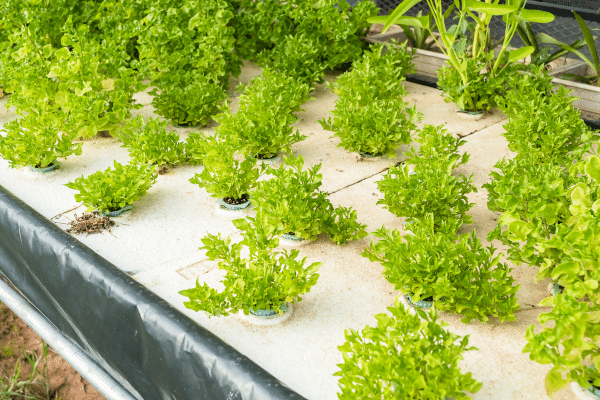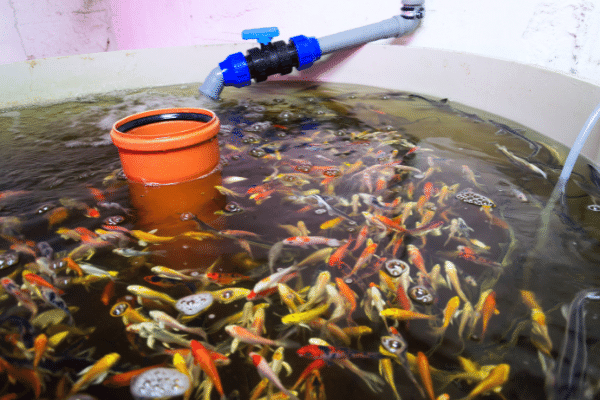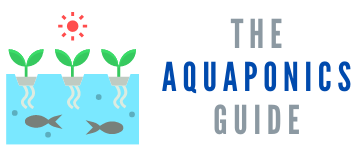How To Choose An Aquaponics System?
Lots of people around the world are setting up their aquaponics system because it has many benefits. Aside from being a planet-friendly solution for food security, an aquaponic system also ensures that you have a safe and cost-effective food source.
More and more people are starting this venture. Unfortunately, not everyone can successfully set up an aquaponics system because it requires the right knowledge and information to make the system work.
If you are planning to start aquaponics at home or are thinking about putting up a large-scale aquaponics project, you are on the right page. Here, you will learn more about the aquaponics system, its benefits, and how to choose one.

What Is An Aquaponics System?
An aquaponics system is the integration of aquaculture and hydroponics. Aquaculture involves breeding and raising aquatic animals like fish, prawns, and snails in a closed environment. Hydroponics, on the other hand, is cultivating plants in water instead of soil.
Aquaponics is an efficient and sustainable way to produce a steady supply of fish and plants as a natural and organic food source. This system harnesses the best qualities of aquaculture and hydroponics without using non-organic fertilizers and with less water wastage.
For the aquaponics system to work, it relies on three primary components – the fish, the plants, and the nitrifying bacteria. Each living component depends on the other to survive and thrive.
The food you feed the aquaponics fish is excreted as waste into the water, which is then converted by bacteria to nourish the plants. By consuming these nutrients, the plants purify the water in return. This symbiotic and sustainable recirculating environment imitates how a natural ecosystem works.
What Are The Benefits Of An Aquaponics System?
Adopting an aquaponics system has undeniable benefits, not only to you as a farmer but also to the planet.
Here are some of the reasons why aquaponics farming is highly beneficial:
- Sustainable intensive food production system
- You get to harvest both plants and fish from one source
- It is water-efficient, does not require soil, and there’s no need to use chemical pesticides and fertilizers
- High-quality production and higher yields
- A more natural farming approach that mimics a natural ecosystem
- It creates little waste and requires lesser labor and maintenance
- Provides a steady food source for protein and vegetables
- A versatile way to have a constant supply of food that can be set up anywhere
How To Choose An Aquaponic System
Technology has made aquaponics systems more viable and accessible. This has helped to address the problems associated with safe and continuous food production.
It’s no wonder why more and more people are interested in setting up their very own aquaponics at home.
Here are some tips and guides on how you can choose an aquaponic system that is suited for your needs and purpose.
1. Know Your Goals and Needs
Before you set up an aquaponics system, you must analyze your goals and purpose.
Will you be using the system for home-use food production, or is it for commercial purposes? Will it be in a freshwater system, brackish water, or saltwater? What methods of growing your aquaponics plant and raising your aquaponic fish will you use?
These are just some of the things you need to ask yourself when planning to set up your own system. Your purpose will be the ultimate guide for building an aquaponics system that would meet your specific needs.
Though easy and efficient, an aquaponic system still needs maintenance and can be an expensive and time-consuming undertaking. So, having a definite purpose and reason to build aquaponics can get you going in the long run.

2. Size And Shape Of The Fish Tank
Fish tanks are one of the critical components of an aquaponic unit. Generally, a fish tank will affect the yield and harvest of your aquaponics system.
Your fish tank must be in proportion with your plant bed. The recommended ratio is 1:1, meaning the volume of the fish tank equals the volume of the grow bed. However, an expert aquaponics grower can make their own ratio depending on how their system works, the type of fish they choose, and their geographic location.
Aside from the size, tank shape also plays a crucial role in your system. Many prefer the oval or round fish tanks over the square and rectangular tanks. This is because round tanks allow even water circulation and good water movement.
Consequently, this increases the oxygen benefits of the fish and the nitrifying bacteria in the system. This also prevents solid wastes from sticking to the corners of the fish tank.
Fish tanks must also be sturdy, waterproof, and toxic-free. You can reuse barrels and containers as long as it was not used for chemical or toxic waste storage.
3. Location Of The Aquaponics System
Choosing the right location and area to set up your unit is vital for the success of your aquaponic system. This is because location will affect the health of the system throughout the year.
Select the right area and location suitable for growing aquaponics plants and fish. Indoor units are easily accessible, and temperature can be controlled. However, artificial lighting is needed to supply the required sunlight. If you want to put your unit outside, make sure that it is safe from harsh weather conditions and adequate sunlight.
4. Aeration
Ensuring adequate air circulation is vital for your aquaponics plant and fish to be healthy and continue to thrive. A good tip is to use air pumps to enhance gas exchange, which removes carbon dioxide and increases oxygen concentration. Air pumps supply the needed air and water pressure to keep the aquaponic ecosystem in balance.
It is also important to cover your tanks to prevent the fish from jumping out. Most freshwater fish are jumpers, and a tank without a lid provides an opportunity for them to escape. Therefore, you must completely cover the tank with a lid.
However, you should make sure that the lid has holes in it to allow adequate air to get in. A mesh or a screen is also a good choice for tank covering for free air exchange and easy access.
5. Water Quality And Circulation
A quality water source is necessary to maintain the cleanliness and safety of the water in your aquaponics system. An excellent water source must be fresh and de-chlorinated. Water contaminants and toxins can kill your aquaponic fish and affect plant growth.
A water pump is also needed to keep the water moving. Water velocity is required for a steady water supply flow and also to keep the pipes clean. Just ensure that you choose the right size and type of water pump for your aquaponics system.
As the lifeblood of an aquaponic unit, clean and healthy water transports the necessary nutrients for plants to grow healthy. Always have a handy water quality test kit to monitor the water quality of your aquaponics system.
6. Stocking Density
Stocking density refers to the amount or number of fish you can grow in your aquaponics unit. A small-sized tank with around 50 gallons of water should have a ration of 1 inch of fish for 1 gallon of water.
If you have a 10-gallon tank, it can hold ten 1-inch sized fish or five 2-inch fish. On the other hand, larger fish tanks with over 50 gallons of water should have a stock density of 1 pound of fish per 5-10 gallons of water.
Overstocking can stress your aquaponic fish and cause diseases. Also, an overcrowded aquaponics unit drastically affects your fish and plant survival rate. On the other hand, a balanced stocking density allows considerable space for plants and fish to grow. Therefore, you should maintain a perfect balance between plants and fish to help keep a steady supply of yield and harvest.

7. Food And Wastes
Feeding and waste management removals are critical factors in maintaining water quality. Uneaten food and excreted wastes are harmful to both fish and plants. These wastes can rot and cause fish diseases.
Fortunately, there are many ways to remove solid wastes from your unit, depending on its specific system design. Some aquaponics farmers use a solid lifting outflow design where a PVC pipe is installed from the bottom of the tank to the water depth to allow solid waste to settle. This also makes it possible to remove the solid waste without letting the fish out of the tank.
Others put a tee inside the tank for cleaning and preventing clogging without letting the fish escape. Additionally, the tee prevents forming a siphon that can potentially empty the tank and kill the fish.
8. Plant And Fish Choice
The aquaponic plants you want to grow will determine the kind of system you will build. Most aquaponic systems are versatile enough to grow various plants and greens like kale, tomatoes, lettuce, and carrots.
Aside from organically grown plants, the plant also plays a crucial role in maintaining your aquaponics system. Plants help the system cycle by oxygenating and cleaning the water through filtering and absorbing water nitrates.
Other than being an excellent protein source, fish also plays a crucial role in an aquaponics unit. Fish waste is a plants’ natural fertilizer. When selecting the type of aquaponics fish, see to it that it is easy to raise, disease-resistant, and readily available in your area. Goldfish, Koi, and Tilapia are among the most commonly raised fish in aquaponics.
9. Cost
The cost to set up and maintain an aquaponics system is one deciding factor to pursue the project or not. Whether it’s a DIY or a purchased system, having your aquaponics involves various expenses.
Depending on the amount you are willing to spend, systems can range from simple DIY budget-friendly designs to elaborate and expensive masterpieces.
To avoid paying a hefty amount for your system, you can opt to get one with manuals and instructions so you can set it up by yourself. Other than the cost of the system, keep in mind additional expenses for operation and maintenance.
Conclusion
A successful aquaponics system needs careful thought and planning. It requires patience, hard work, and determination.
However, setting up and maintaining your system is a gratifying and satisfying experience. Don’t get discouraged by the few mishaps and challenges along the way. Once you have set up your aquaponics system, you can now start aquaponics farming whether as a hobby or as a regular income generator.
